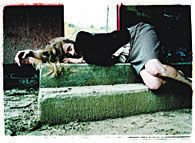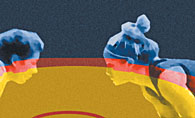Off campus
Grazing
Sweet summer, be not gone ... At least on a sunny day we can fake it by heading to nearby Via Vivoli for some splendid gelato. There are dazzling flavours like Ferrero Rocher and crème caramel; but smooth, cool and simple hazelnut, chocolate and mango are top sellers.
And when the temperature sinks low enough that we can no longer fool ourselves, take away their Godiva chocolates for consolation.
Like a pig to truffles, seek out Via Vivoli in the Simons food court (977 St. Catherine W.) or in the Eaton Centre (705 St. Catherine W.).
Browsing
Who knows that dasypygal means having hairy buttocks? Anyone who subscribes to "a word a day" through www.wordsmith.org. Other wonderful and weird words can wend their way to your email box daily. Subscribe (for free!) to words of the day at the following dictionary sites: Merriam Webster (www.m-w.com), www.dictionary.com and home.mn.rr.com/wwftd for a "worthless word" (is there such a thing?).
Visit the venerable Oxford English Dictionary (dictionary.oed.com) for their daily word, and check the archives of randomhouse.com/wotd.
Another browseworthy site is www.wordorigins.com, or head to www.onelook.com for a list of online dictionaries, such as the Quirky Grandiloquent Dictionary for several thousand oddities of the English language.
Launching

Are our nation's top art photographers obsessed with death? Penny Cousineau-Levine, of Concordia University, thinks so. She will do for Canadian photography with her book Faking Death: Canadian Art Photography and the Canadian Imagination what Margaret Atwood did for Canadian literature with her critical opus Survival. McGill-Queen's University Press launches Faking Death on Wednesday, Sept. 17, 5:00 pm – 7:00 pm at Gallerie Observatoire 4, 372 St. Catherine W., #426.
The real face of wrestling
It's 4:30 on June 19, 2003, a muggy day in Indianapolis. Wrestlers are "cutting weight" (that is, "dehydrating themselves") in various ways in a ballroom in the Adam's Mark Hotel, site of the 2003 U.S.A. World Team Trials. Some pedal away on stationary bikes, wearing three sweatshirts with the hoods pulled down low over the forehead; some sit on benches in their underwear in the 37-degree sauna, elbows on their knees and head in their hands. They slap each other's backs and massage each other to induce sweating. Some of them will lose 10 percent of their body weight (in water) by weigh-in time of 5:00 sharp. At that time, all wrestlers must weigh at or below the limit for their weight category.

Tzigane
The World Team Trials begin the next morning, and the wrestlers hope to gain back all they lose today throughout the night. By maintaining a natural weight above the limit for their weight category and "cutting" down to the limit, they can keep a few added pounds of muscle, making them stronger than anyone who stayed strictly below the limit.
All carry a smouldering sulk in their glazed eyes. It is there even as they joke and chat with their teammates, and it represents the fine line wrestlers walk between humility and pride. Without the humility, they would not be able to endure the physical punishment of training or the eventual inevitability of losing; without the pride and desire to win, they would have no drive. Wrestling entails an internal struggle alongside the external one, leading to a razor-sharp edge between extremes of tension and relaxation, where pure instinct drives every action.
Each person's struggle and their response to it shows plainly on their game face, which they don at weigh-ins and do not remove until after the tournament. These faces can reflect all the turbulence of competition; they can also reflect the serenity of pure focus. Some faces are fierce and some are calm. Some wrestlers grimace as they grapple, and some stare blankly ahead. Every face is its own unique combination of desire and doubt, thought and emotion, confidence and anxiety. Competitors don't think about their game faces or practice them in the mirror; they just put them on. Intense, unmediated and instinctive, they are raw sketches of struggle.
A wrestler wears her singlet and her wrestling shoes onto the mat. The singlet is one piece, made of skin-tight lycra and the shoes are soft and flexible, but with rubber soles. Shoelaces must be covered or taped so that they do not come untied during the match (before this rule was created, wrestlers would stall for time by tying their shoelaces). Long hair must be tied back with a rubber band containing no metal; many girls with long hair braid their hair into tiny braids. Wrestlers with poor vision must wear contact lenses or wrestle blind.
The U.S.A. World Team Trials is one of the top elite events in American wrestling, attracting thousands of spectators every year. In each weight category, those who placed in the top eight at the U.S. National Open tournament wrestle each other for the number one spot, or for a place on the U.S. National Team (which takes those who rank firstthrough third). America's best wrestlers, including world champions and Olympians, compete at this event.
I was lucky enough to attend this tournament not as a spectator, but as a participant. A spectator would miss details like the sound of a winded wrestler gasping for air; she might not hear the referee's flat tone of voice as he says, "Zone blue," warning a wrestler to stay in bounds; and she certainly would not catch the glint in the eyes of fellow competitors. A spectator would constantly strain to see the competitors' faces, the focal points of their effort. As a participant, I was privy to these faces -- some of them played out their expressions inches from my own.
One of my opponents had beaten me easily at a previous tournament. When our match at the World Team Trials began, her face was calm and confident, her waist-length hair meticulously braided and looped in a clean bun. But as it became clear to her that it would not be an easy match, a hint of frustration and even fear crept into her expression. The corners of her mouth turned down, but even as she lost the match, her disappointment carried a note of indignation.
We faced each other again at the end of the tournament. Her face showed uncertainty and a shaky confidence. Her hair had been pulled out of its neat bun and runaway braids hung by her ears. Her anxiety allowed me to beat her again, and this time the indignation did not show through the dejection.
Another of my opponents never showed emotion. The beautiful mask of serenity that she wore as she beat me remained on her face throughout the tournament. Even as she was taken down, even as she lost a match to another opponent, her expression never changed.
One young wrestler had lost to me by a single point in a difficult match at a previous tournament. Her face shone with childlike disbelief at the end of our match as her hand was raised -- this time she was the victor.
In all of my matches, I can imagine my own grimace as I have seen it on videotape: with bared teeth and slitted eyes, I could almost be smiling.
The spectators miss the details of weigh-ins, the stomach butterflies and the muscles that feel like jelly. They might see some wrestlers' expressions from afar or on the big screen. But the intensity of the expression is incomparable to when the face belongs to your opponent on the mat.
There's another face I would have missed as a spectator. After the match, a small blonde girl approached me. She held an event programme and a permanent marker. "Will you sign my program?" she asked. I was surprised, but signed my name with the generic message, "Be a champion!" Perhaps the best expression of the whole tournament was the look of shy thanks on that little girl's face.
After placing sixth at the World Team Trials, Hana Askren attended three training camps at the U.S. Olympic Training Center in Colorado Springs. She intends to compete at the Olympic trials in May 2004. A recent graduate of McGill, she will be assistant coach for McGill's wrestling team this fall, as well as lab assistant for Islamic Studies professor Michelle Hartman.
